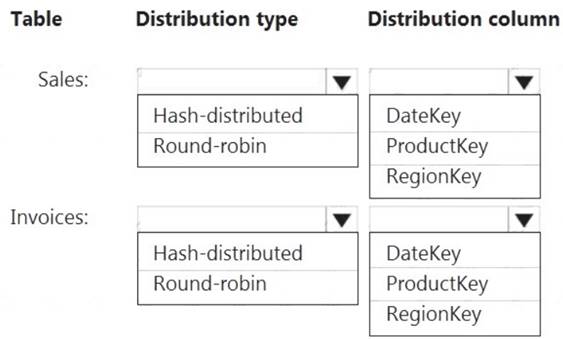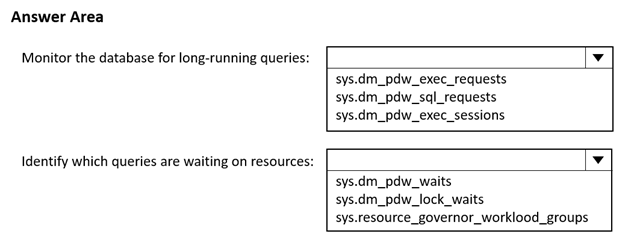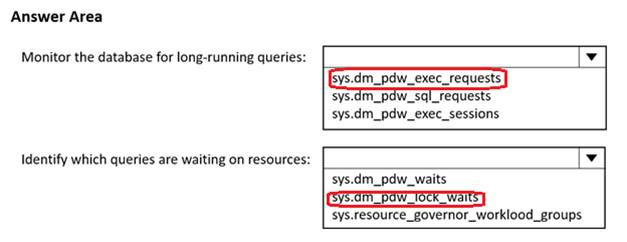- (Exam Topic 3)
You have an Azure subscription linked to an Azure Active Directory (Azure AD) tenant that contains a service principal named ServicePrincipal1. The subscription contains an Azure Data Lake Storage account named adls1. Adls1 contains a folder named Folder2 that has a URI of https://adls1.dfs.core.windows.net/container1/Folder1/Folder2/.
ServicePrincipal1 has the access control list (ACL) permissions shown in the following table.
You need to ensure that ServicePrincipal1 can perform the following actions:  Traverse child items that are created in Folder2.
Traverse child items that are created in Folder2. Read files that are created in Folder2.
Read files that are created in Folder2.
The solution must use the principle of least privilege.
Which two permissions should you grant to ServicePrincipal1 for Folder2? Each correct answer presents part of the solution.
NOTE: Each correct selection is worth one point.
Correct Answer:
DF
Execute (X) permission is required to traverse the child items of a folder.
There are two kinds of access control lists (ACLs), Access ACLs and Default ACLs. Access ACLs: These control access to an object. Files and folders both have Access ACLs.
Default ACLs: A "template" of ACLs associated with a folder that determine the Access ACLs for any child items that are created under that folder. Files do not have Default ACLs.
Reference:
https://docs.microsoft.com/en-us/azure/data-lake-store/data-lake-store-access-control
- (Exam Topic 3)
You have an Azure Data Lake Storage account that contains a staging zone.
You need to design a daily process to ingest incremental data from the staging zone, transform the data by executing an R script, and then insert the transformed data into a data warehouse in Azure Synapse Analytics.
Solution: You use an Azure Data Factory schedule trigger to execute a pipeline that executes mapping data Flow, and then inserts the data info the data warehouse.
Does this meet the goal?
Correct Answer:
B
If you need to transform data in a way that is not supported by Data Factory, you can create a custom activity, not a mapping flow,5 with your own data processing logic and use the activity in the pipeline. You can create a custom activity to run R scripts on your HDInsight cluster with R installed.
Reference:
https://docs.microsoft.com/en-US/azure/data-factory/transform-data
- (Exam Topic 3)
You have an on-premises data warehouse that includes the following fact tables. Both tables have the following columns: DateKey, ProductKey, RegionKey. There are 120 unique product keys and 65 unique region keys.
Queries that use the data warehouse take a long time to complete.
You plan to migrate the solution to use Azure Synapse Analytics. You need to ensure that the Azure-based solution optimizes query performance and minimizes processing skew.
What should you recommend? To answer, select the appropriate options in the answer area.
NOTE: Each correct selection is worth one point
Solution:
Box 1: Hash-distributed
Box 2: ProductKey
ProductKey is used extensively in joins.
Hash-distributed tables improve query performance on large fact tables. Box 3: Round-robin
Box 4: RegionKey
Round-robin tables are useful for improving loading speed.
Consider using the round-robin distribution for your table in the following scenarios:  When getting started as a simple starting point since it is the default
When getting started as a simple starting point since it is the default If there is no obvious joining key
If there is no obvious joining key If there is not good candidate column for hash distributing the table
If there is not good candidate column for hash distributing the table  If the table does not share a common join key with other tables
If the table does not share a common join key with other tables If the join is less significant than other joins in the query
If the join is less significant than other joins in the query  When the table is a temporary staging table
When the table is a temporary staging table
Note: A distributed table appears as a single table, but the rows are actually stored across 60 distributions. The rows are distributed with a hash or round-robin algorithm.
Reference:
https://docs.microsoft.com/en-us/azure/sql-data-warehouse/sql-data-warehouse-tables-distribute
Does this meet the goal?
Correct Answer:
A
- (Exam Topic 3)
You have an Azure Synapse Analytics dedicated SQL pool.
You need to monitor the database for long-running queries and identify which queries are waiting on resources Which dynamic management view should you use for each requirement? To answer, select the appropriate options in the answer area.
NOTE; Each correct answer is worth one point.
Solution:
Does this meet the goal?
Correct Answer:
A
- (Exam Topic 3)
You have an Azure Synapse Analytics dedicated SQL pool named SA1 that contains a table named Table1. You need to identify tables that have a high percentage of deleted rows. What should you run?
A)
B)
C)
D)
Correct Answer:
B

